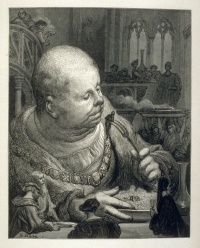16th century in literature
From The Art and Popular Culture Encyclopedia
| Revision as of 23:34, 10 January 2010 Jahsonic (Talk | contribs) ← Previous diff |
Revision as of 23:34, 10 January 2010 Jahsonic (Talk | contribs) Next diff → |
||
| Line 16: | Line 16: | ||
| *''[[Books of secrets]]'' by various | *''[[Books of secrets]]'' by various | ||
| - | *''[[The Book of the Courtier]]'' by | + | *''[[The Book of the Courtier]]'' by [[Baldassare Castiglione]] |
| *''[[Utopia (Novel)|Utopia]]'' by [[Thomas More]] | *''[[Utopia (Novel)|Utopia]]'' by [[Thomas More]] | ||
| == See also == | == See also == | ||
Revision as of 23:34, 10 January 2010
|
Related e |
|
Featured: |
Literature in the 16th century was still the province of a happy few, the movable type printing press was only a recent invention. Important books include Gargantua and Pantagruel by Rabelais, In Praise of Folly by Erasmus and Heptameron by the Queen of Navarre.
Medieval romances were reduced to cheap and abrupt plots resembling modern comic books. Neither were the first collections of novels necessarily prestigious projects. They appeared with an enormous variety from folk tales over jests to stories told by Boccaccio and Chaucer, now venerable authors.
A more prestigious market of romances developed in the 16th century, with multi-volume works aiming at an audience which would subscribe to this production. The criticism levelled against romances by Chaucer's pilgrims grew in response both to the trivialisations and to the extended multi-volume "romances". Romances like the Amadis de Gaula led their readers into dream worlds of knighthood and fed them with ideals of a past no one could revitalise, or so the critics complained.
Italian authors like Machiavelli were among those who brought the novel into a new format: while it remained a story of intrigue, ending in a surprising point, the observations were now much finer: how did the protagonists manage their intrigue? How did they keep their secrets, what did they do when others threatened to discover them?
Curiosities included Hermaphroditus, Book of Kisses, Portrait of Lozana: The Lusty Andalusian Woman and The Book of the Prick.
Titles
- Books of secrets by various
- The Book of the Courtier by Baldassare Castiglione
- Utopia by Thomas More
See also
- New literature published in the 16th century
- Births and deaths in 16th century literature
- 16th century in poetry
- Early Modern literature
- Renaissance literature
- 17th century literature


